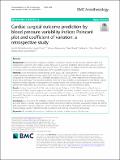Cardiac surgical outcome prediction by blood pressure variability indices Poincaré plot and coefficient of variation: a retrospective study
Author(s)
Packiasabapathy, Senthil; Prasad, Varesh; Rangasamy, Valluvan; Popok, David; Xu, Xinling; Novack, Victor; Subramaniam, Balachundhar; ... Show more Show less
Download12871_2020_Article_972.pdf (1.008Mb)
Publisher with Creative Commons License
Publisher with Creative Commons License
Creative Commons Attribution
Terms of use
Metadata
Show full item recordAbstract
Background
Recent literature suggests a significant association between blood pressure variability (BPV) and postoperative outcomes after cardiac surgery. However, its outcome prediction ability remains unclear. Current prediction models use static preoperative patient factors. We explored the ability of Poincaré plots and coefficient of variation (CV) by measuring intraoperative BPV in predicting adverse outcomes.
Methods
In this retrospective, observational, cohort study, 3687 adult patients (> 18 years) undergoing cardiac surgery requiring cardio-pulmonary bypass from 2008 to 2014 were included. Blood pressure variability was computed by Poincare plots and CV. Standard descriptors (SD) SD1, SD2 were measured with Poincare plots by ellipse fitting technique. The outcomes analyzed were the 30-day mortality and postoperative renal failure. Logistic regression models adjusted for preoperative and surgical factors were constructed to evaluate the association between BPV parameters and outcomes. C-statistics were used to analyse the predictive ability.
Results
Analysis found that, 99 (2.7%) patients died within 30 days and 105 (2.8%) patients suffered from in-hospital renal failure. Logistic regression models including BPV parameters (standard descriptors from Poincare plots and CV) performed poorly in predicting postoperative 30-day mortality and renal failure [Concordance(C)-Statistic around 0.5]. They did not add any significant value to the standard STS risk score [C-statistic: STS alone 0.7, STS + BPV parmeters 0.7].
Conclusions
In conclusion, BP variability computed from Poincare plots and CV were not predictive of mortality and renal failure in cardiac surgical patients. Patient comorbid conditions and other preoperative factors are still the gold standard for outcome prediction. Future directions include analysis of dynamic parameters such as complexity of physiological signals in identifying high risk patients and tailoring management accordingly.
Date issued
2020-03Department
Massachusetts Institute of Technology. Institute for Medical Engineering & Science; Harvard University--MIT Division of Health Sciences and TechnologyJournal
BMC Anesthesiology
Publisher
Springer Science and Business Media LLC
Citation
Packiasabapathy, Senthil et al. "Cardiac surgical outcome prediction by blood pressure variability indices Poincaré plot and coefficient of variation: a retrospective study." BMC Anesthesiology 20,1 (March 2020): 56 © 2020 BioMed Central Ltd
Version: Final published version
ISSN
1471-2253